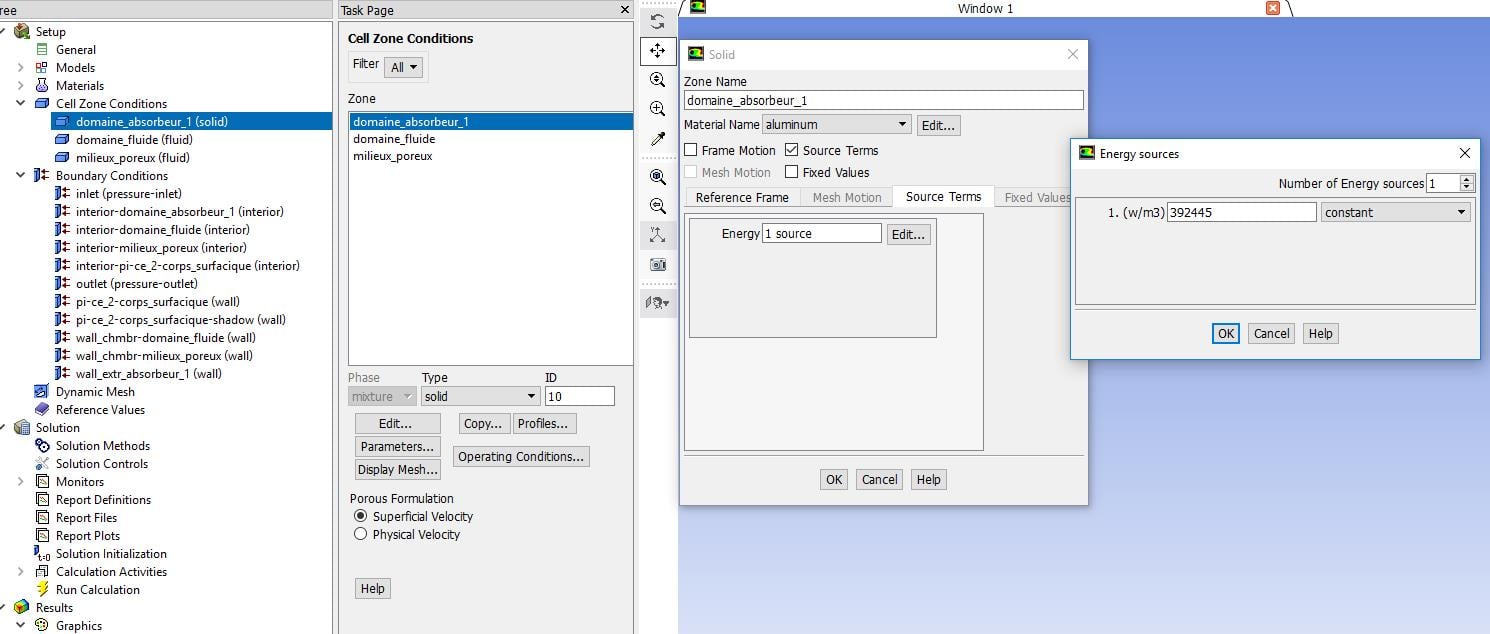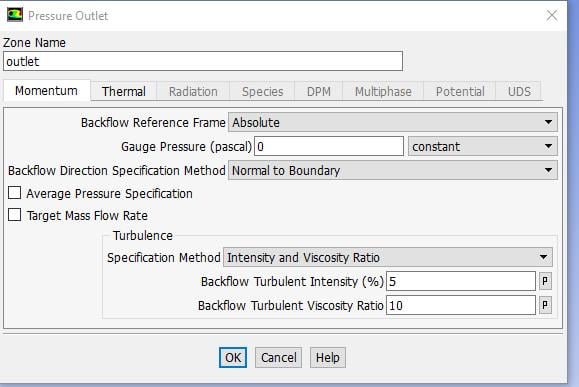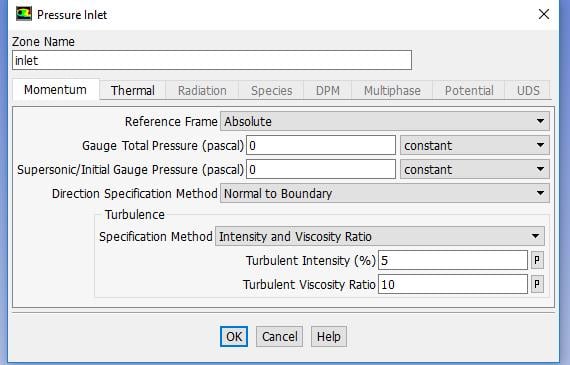-
-
June 27, 2019 at 11:34 pm
douniaextra1
SubscriberHello everyone!
I was simulating a square box with trays as a porous media, where the air is flowing from the inlet passing by the porous media and then go out from the outlet. I only entered the power-law coefficients C0 C1 and the porosity. but then I realised that there is something wrong with it, because I found that in both cases with or without porous media it shows the same results. so I was wondering if someone can help me with this and show me how to simulate a porous media using the power law coefficients? I'll be so grateful for any comments or answers. Thanks.
-
June 28, 2019 at 1:22 pm
Amine Ben Hadj Ali
Ansys EmployeeIn the User's Guide you will find tips how to calculate the inertial and permeability coefficients based on your measured / know pressure drop or Ergun's like approximation.
This can be helpful 2:
https://youtu.be/T-2wfMQwYms
-
June 28, 2019 at 2:40 pm
douniaextra1
SubscriberThank you so much for answering me. But I have no measurements to calculate the inertia and permeability coefficients. all I have is C0 and C1 the power law model coefficients.
Is it wrong to use just the power law model without the inertia and permeability coefficients ?
Best regards,
Dounia
-
July 1, 2019 at 5:11 am
Amine Ben Hadj Ali
Ansys EmployeeNo is not wrong. -
July 1, 2019 at 12:00 pm
douniaextra1
Subscriberso why it doesn't work? there is absolutely no difference between adding porous media and take it off, it's like FLUENT does not take in count the power-law coefficients.
Best regards,
Dounia
-
July 1, 2019 at 12:37 pm
Amine Ben Hadj Ali
Ansys EmployeeYou will get the same velocity etc.. Only the contour of pressure is different across the porous zone if you are not using the physical formulation.
-
July 1, 2019 at 2:04 pm
douniaextra1
Subscriberthe contour of pressure does not change if I take off the porous media,
in your opinion, where is the problem?
Best regards,
Dounia
-
July 1, 2019 at 2:09 pm
-
July 1, 2019 at 3:34 pm
Amine Ben Hadj Ali
Ansys EmployeeAdd more details about case settings, cell zone and boundary conditions. What is the aim of this run? Are you comparing to a Fluent run? -
July 1, 2019 at 3:56 pm
douniaextra1
Subscribercan I have your email so I can send to you a report PDF that contains the details about my simulation step by step, or you can send me a message in my Gmail: douniaextra1@gmail.com
Best regards,
Dounia
-
July 1, 2019 at 4:29 pm
Amine Ben Hadj Ali
Ansys EmployeeNo I'm sorry. Stick to the community please. -
July 1, 2019 at 7:44 pm
douniaextra1
Subscriberit's ok, I understand. well, I'm just gonna send you some pictures so you can understand my geometry and what I'm trying to do.
first of all, here is my geometry:
this is a drying chamber made of wood with 2 trays as a porous media. air is heated at the bottom by
the mean of a horizontal absorber which is considered as a source of energy
The air flows into the dryer through an inlet, absorbs energy (heat) from the absorber (Aluminum), flows
through the drying chamber and outflows from the outlet.
trays were assumed as porous media for airflow. It is modeled by the power law model using C0 and C1.
boundary conditions in the inlet: P= 100000 Pa and T=304 K
boundary conditions in the outlet: P= 100000 Pa
Wooden wall boundary conditions: u=v=0
there is convective loss in all the walls and in the absorber,
the standard k-? model is used to describe the flow.
I know it's a lot but please be patient with me, and again I'm so grateful for keeping answering me
Best regards,
Dounia
-
July 2, 2019 at 4:40 am
Amine Ben Hadj Ali
Ansys EmployeeI guess they took buoyancy effects into account. -
July 2, 2019 at 8:40 am
douniaextra1
SubscriberI entered the gravity value... Please! can you check for me those pictures and see if there is something wrong.
-
July 2, 2019 at 9:24 am
Rob
Forum ModeratorWhat density model did you use?
-
July 2, 2019 at 10:26 am
douniaextra1
Subscriberfor air, I'm using Boussinesq density
-
July 2, 2019 at 12:02 pm
-
July 2, 2019 at 12:07 pm
Amine Ben Hadj Ali
Ansys EmployeeAs the communication is not really optimal can you use ideal gas density and provide as operating density the density corresponding to the surrounding temperature (if the same at inlet and outlet).
-
July 2, 2019 at 12:25 pm
douniaextra1
SubscriberIt didn't work!
in solution initialization, I realized that the turbulence coefficients equals Zero, is that something wrong?
-
July 2, 2019 at 12:27 pm
Amine Ben Hadj Ali
Ansys EmployeeHey what did not work: If you want us to help: be patient and provide details!
Regarding the values of TKE and EPSILON: Yes that might lead to problem. Make ini from Inlets or do a hybrid ini as you have pressure boundaries!
-
July 2, 2019 at 12:43 pm
douniaextra1
SubscriberI'm sorry if it seems that I'm not patient. But I'm truly patient and trying to provide you with all the details.
what I was trying to say, is that I used ideal gas density but it still the same problem.
I tried to enter the turbulence coefficients randomly( i tried different values) in the inlet and outlet. Yes, there is a change but it has nothing to do with the results that I want to achieve.
I tried also the Hybrid initialization, it gave me the same result.
Best regards,
Dounia
-
July 2, 2019 at 2:10 pm
Amine Ben Hadj Ali
Ansys EmployeeIs the reference case transient? Do you have information on that?
I have not asked to modify the values at inlet/outlet but to initialize as Hybrid or initialize from Inlet.
Using Ideal gas density: have you set the operating density to the surrounding density?
-
July 2, 2019 at 2:45 pm
-
July 2, 2019 at 2:49 pm
Amine Ben Hadj Ali
Ansys EmployeeAnd are you sure that the picture from their runs is an instantaneous contour plots or rather an average one?
That density corresponds to which temperature? Is that the same temperature you used at inlet and outlets? I hope 304 K.
What about now you mesh resolution: you require a good near wall mesh with at least 10 cells in the boundary layers. Yplus of one is a must here. I will then use SST model as turbulence model.
-
July 2, 2019 at 2:51 pm
Amine Ben Hadj Ali
Ansys Employee304 K> 1.161191 kg/m³
-
July 2, 2019 at 3:03 pm
-
July 2, 2019 at 3:13 pm
douniaextra1
Subscriberthank you for the density, I didn't know it before
-
July 3, 2019 at 7:23 am
Amine Ben Hadj Ali
Ansys EmployeeYou need to use the density corresponding to the surrounding and the surrounding is at 304 K.
-
July 4, 2019 at 9:02 am
-
July 4, 2019 at 10:33 am
Amine Ben Hadj Ali
Ansys EmployeeThat is only for initialization (steady-state not really heartbreaking) but is not okay if it shows zero values. Can you reset and then repeat "Compute from" Inlet".
-
July 4, 2019 at 10:34 am
Amine Ben Hadj Ali
Ansys EmployeePlease remove the mark as "Is Solved" as it is irritating a bit. (if you can remove that).
-
July 4, 2019 at 10:41 am
douniaextra1
SubscriberI tried to reset but it still giving me Zero,
and I tried also to remove the mark "is solved" but I couldn't, it was just accidentally.
Best regards,
Dounia
-
July 4, 2019 at 11:38 am
Amine Ben Hadj Ali
Ansys EmployeeProvide a value and then try to compute from all zones and then back from inlet.
-
July 6, 2019 at 9:00 am
douniaextra1
SubscriberI have no measurements to calculate the K and epsilon value, and I have no idea how these values should be, can you give me certain values?
Best regards,
Dounia
-
July 8, 2019 at 11:00 am
Amine Ben Hadj Ali
Ansys EmployeeThat are initial values: Start with moderate values. Have a look into Inlet turbulence quantities in the User's Guide and use that for domain initialization
-
July 12, 2019 at 11:15 am
douniaextra1
SubscriberHi!
in this flow, I used the inertial and viscous resistance to model the porous media, But again I have a problem, the air doesn't cross the porous media as you can see, it work as an obstacle, even if I changed the porosity nothing changes!!
please, can you tell me why the air does not cross the porous media?
what should I do? so the air can cross the porous media.
Why when I changed the porosity the flow does not change?
Best regards and best wishes,
Dounia
-
July 13, 2023 at 2:22 pm
Lucy
SubscriberHi! Did you solve this problem? I'm struggling with a similar issue.
-
-
July 12, 2019 at 11:27 am
Amine Ben Hadj Ali
Ansys EmployeePost your porous media settings here.
-
July 12, 2019 at 11:42 am
-
July 12, 2019 at 12:22 pm
Amine Ben Hadj Ali
Ansys EmployeeAre you sure about the inverse permeability coefficients and inertia? How did you calculate that? Post the velocity vectors please.
-
July 12, 2019 at 12:28 pm
douniaextra1
SubscriberI don't have a velocity vector, I used different values of inertial and viscous resistance that I take from articles or youtube videos, but it still the same problem.
-
July 12, 2019 at 12:29 pm
Amine Ben Hadj Ali
Ansys EmployeeShow the velocity vectors Graphics>Vectors.
So do not know the values which is required for you case right?
-
July 12, 2019 at 12:45 pm
-
July 12, 2019 at 1:33 pm
Amine Ben Hadj Ali
Ansys EmployeeWhere is the porous zone located in your screenshots? Please help us to understand so that we can help you.
Please share the residual plot of the run.
-
August 2, 2023 at 1:16 pm
Salman ayyoob
SubscriberHi sir /madam
I want to know , if we use non darcy equation ( for turbulent flow in porous media) and we have provided viscous resistance only, do we get the correct result? or we also have to calculate the inertial resistance and apply interial resistance as well ?
Would we need to provide power law also or not?
-
August 3, 2023 at 4:17 pm
Salman ayyoob
SubscriberI have calculated 1/a after modification in hydraulic gradient (i) and provied the value of 1/a only for non darcy range(turbulent flow condition), and I am getting results close to the experimental result.
So, do you think it ould be correct?
And also tell me when will we use power law?
-
-
August 2, 2023 at 2:07 pm
Rob
Forum ModeratorIf you don't provide all of the data then you may find the resistance isn't as expected, but as you don't have all the data you may not know the result isn't as you'd expect.
-
August 4, 2023 at 8:48 am
Rob
Forum ModeratorIt could be correct, that's something you need to check for yourself.
I don't think I've ever used the Power Law option. Looking at the maths it's for when the more usual form doesn't fit the pressure loss data.
-
- The topic ‘Porous media in FLUENT’ is closed to new replies.



-
4673
-
1565
-
1386
-
1231
-
1021

© 2025 Copyright ANSYS, Inc. All rights reserved.


























.png)






